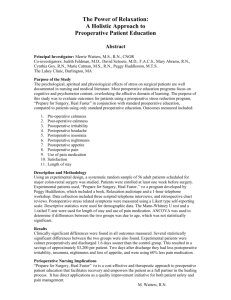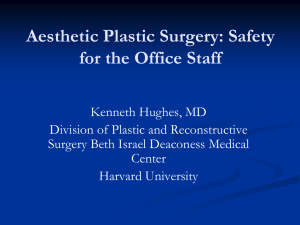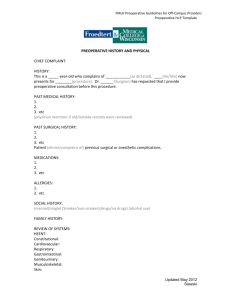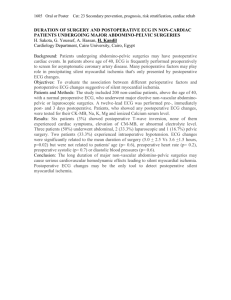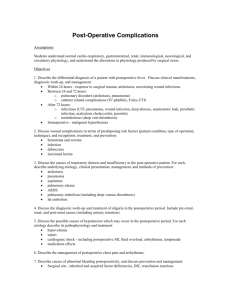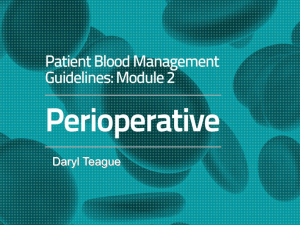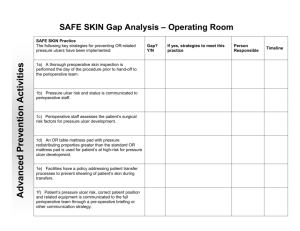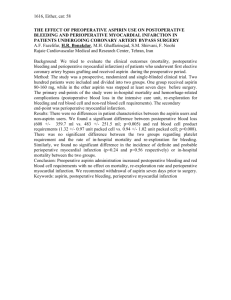Preoperative orders
advertisement
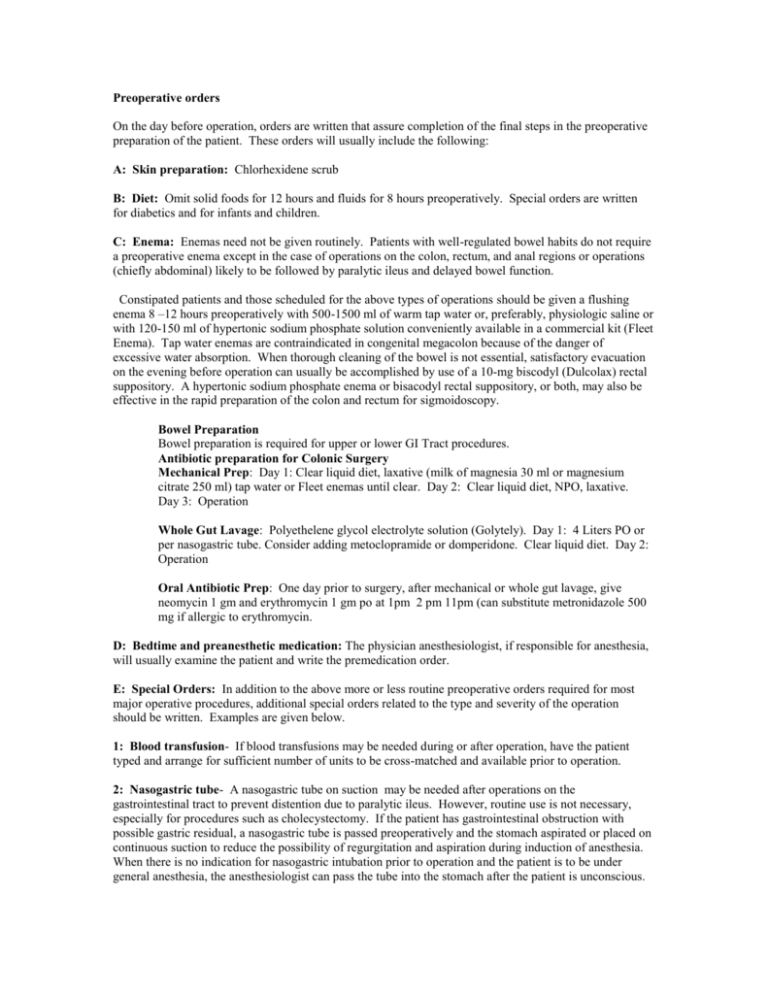
Preoperative orders On the day before operation, orders are written that assure completion of the final steps in the preoperative preparation of the patient. These orders will usually include the following: A: Skin preparation: Chlorhexidene scrub B: Diet: Omit solid foods for 12 hours and fluids for 8 hours preoperatively. Special orders are written for diabetics and for infants and children. C: Enema: Enemas need not be given routinely. Patients with well-regulated bowel habits do not require a preoperative enema except in the case of operations on the colon, rectum, and anal regions or operations (chiefly abdominal) likely to be followed by paralytic ileus and delayed bowel function. Constipated patients and those scheduled for the above types of operations should be given a flushing enema 8 –12 hours preoperatively with 500-1500 ml of warm tap water or, preferably, physiologic saline or with 120-150 ml of hypertonic sodium phosphate solution conveniently available in a commercial kit (Fleet Enema). Tap water enemas are contraindicated in congenital megacolon because of the danger of excessive water absorption. When thorough cleaning of the bowel is not essential, satisfactory evacuation on the evening before operation can usually be accomplished by use of a 10-mg biscodyl (Dulcolax) rectal suppository. A hypertonic sodium phosphate enema or bisacodyl rectal suppository, or both, may also be effective in the rapid preparation of the colon and rectum for sigmoidoscopy. Bowel Preparation Bowel preparation is required for upper or lower GI Tract procedures. Antibiotic preparation for Colonic Surgery Mechanical Prep: Day 1: Clear liquid diet, laxative (milk of magnesia 30 ml or magnesium citrate 250 ml) tap water or Fleet enemas until clear. Day 2: Clear liquid diet, NPO, laxative. Day 3: Operation Whole Gut Lavage: Polyethelene glycol electrolyte solution (Golytely). Day 1: 4 Liters PO or per nasogastric tube. Consider adding metoclopramide or domperidone. Clear liquid diet. Day 2: Operation Oral Antibiotic Prep: One day prior to surgery, after mechanical or whole gut lavage, give neomycin 1 gm and erythromycin 1 gm po at 1pm 2 pm 11pm (can substitute metronidazole 500 mg if allergic to erythromycin. D: Bedtime and preanesthetic medication: The physician anesthesiologist, if responsible for anesthesia, will usually examine the patient and write the premedication order. E: Special Orders: In addition to the above more or less routine preoperative orders required for most major operative procedures, additional special orders related to the type and severity of the operation should be written. Examples are given below. 1: Blood transfusion- If blood transfusions may be needed during or after operation, have the patient typed and arrange for sufficient number of units to be cross-matched and available prior to operation. 2: Nasogastric tube- A nasogastric tube on suction may be needed after operations on the gastrointestinal tract to prevent distention due to paralytic ileus. However, routine use is not necessary, especially for procedures such as cholecystectomy. If the patient has gastrointestinal obstruction with possible gastric residual, a nasogastric tube is passed preoperatively and the stomach aspirated or placed on continuous suction to reduce the possibility of regurgitation and aspiration during induction of anesthesia. When there is no indication for nasogastric intubation prior to operation and the patient is to be under general anesthesia, the anesthesiologist can pass the tube into the stomach after the patient is unconscious. 3: Bladder catheter- If it appears the patient will need hourly monitoring of urinary output during or after operation or if postoperative urinary retention is anticipated, a Foley catheter is inserted for constant bladder drainage. If bladder distention will interfere with exposure in the pelvis (e.g. During abdominoperineal resection), a catheter should be placed preoperatively. Catheterization can be done on the nursing unit just before the patient leaves for the operating room or after anesthetization. 4: Venous access and hemodynamic monitoring- Operations associated with marked blood loss call for preoperative placement of one or two 14- or 16-guarge intraveneous plastic catheters for rapid administration of blood, fluids, or medication. Percutaneous insertion is usually possible: if not, a cutddown should be done to expose a vein, usually the antecubital. Central venous pressure monitoring may be required. 5: Preoperative hydration- In large vascular procedures where adequate renal perfusion is essential or when a patinet is thought to be relatively hypovolemic before a major operation – as frequently occurs in the cancer patinet with weight loss or one with gastrointestinal disease – preoperative intravenous hydration with crystalloid beginning the night before surgery is indicated. 6: Continuing medications- Certain patients will be receiving continuing medications whose dosage or route of administration must be altered as the result of operation. Insulin and corticosteroids are examples of hormone preparations requiring special preoperative orders. Digitalis, other cardiac drugs, antibiotics, etc, may require a shift to the parenteral route of administration and altered dosage in the immediate preoperative period and during operation. Foresight in the adjustment of medication orders will minimize the possibility of underdosage or overdosage of potent and essential drugs. Insulin Sliding Scale - and diabetics Glucose Action <4 Call 4.1 – 10 0 10.1 – 12 4 12.1 – 14 6 14.1 – 16 8 16.1 – 20 10 20.1 – 24 12 >24 Call Dextrose 5% at 100 cc per hour - Piggy Back 50 Units of Toronto Insulin in 500 cc of NS (1 unit in 10cc’s) then adjust the insulin infusion to give 1, 2, or 3 units per hour. **** Consult Internal Medicine**** DVT Prophylaxis Heparin 5000 Units SC on call to OR Solucortef (hydrocortisone hemisuccinate) 100mg IV on call to OR 7: Prophylactic antibiotics 8: Consult….. Internal Medicine….. ICU 9: Laboratory Tests - CBC & diff., INR, PTT, Creat., BUN, PFT, CxR, EKG, Group & Screen Postoperative Orders Detailed treatment orders should be written upon arrival in the recovery room. Unusual or particularly important orders should also be communicated to the nursing team orally. The nursing team must also be advised of the nature of the operation and the patient’s condition. Postoperative orders should cover the following: A: Monitoring 1: Vital signs- Blood pressure, pulse, and respiration should be recorded every 15 – 30 minutes until stable and then hourly until discharge from the recovery room. The frequency of vital sign measurements thereafter depends upon the nature of the operation and the patient’s course in the recovery room. When an arterial catheter is in place, blood pressure and pulse should be monitored continuously. Continuous electrocardiographic monitoring is indicated in most patients in the recovery room. Any major changes in vital signs should be communicated to the anesthesiologist and surgeon immediately. Temperature is usually recorded every 4 hours, some patients become hypothermic during operation and others have fever before operation, these people are monitored more frequently. 2: Central venous pressure- Central venous pressure should be recorded periodically in the early postoperative period if the operation has entailed large blood losses or fluid shifts. A Swan-Ganz catheter for measurement of pulmonary artery wedge pressure is indicated under these conditions if the patient has borderline cardiac or respiratory function. 3: Fluid balance- A record is maintained by the anesthesiologist of all fluid administered and all blood loss and urine output during the operation. This record should be continued in the postoperative period and should also include fluid losses from drains and stomas. This information aids in assessing hydration and guides intravenous fluid replacement. In operations where fluid shifts are great or when renal function is marginal, a bladder catheter should be placed for frequent measurement of urine output. The rate of urine flow in catheterized patients is monitored as the vital signs are, usually hourly. If no catheter is present, the surgeon should be notified of the patient does not void by a certain time, preferably 6 hours after operation. 4: Other types of monitoring- Depending on the nature of the operation and the patient’s preexisting conditions, other types of monitoring may be necessary. Examples include measurement of intracranial pressure and level of consciousness following cranial surgery and monitoring of distal pulses following vascular surgery or in patients with casts. B: Respiratory Care: In the early postoperative period, the patient may remain mechanically ventilated or treated with supplemental oxygen by mask or nasal prongs. These orders should be specified. In intubated patients, tracheal suctioning or other forms of respiratory therapy should be ordered as required. Patients who are not intubated should be encouraged to take deep breaths frequently to prevent atelectasis. C: Position In Bed and Mobilization: The postoperative orders should describe any required special positioning of the patient. Unless contraindicated, the patinet should be turned from side to side every 30 minutes until conscious and then hourly for the first 8-12 hours to minimize atelectasis. Early ambulation is encouraged to reduce venous stasis. Venous stasis may also be minimized by intermittent compression of the calf by a pneumatic device. D: Diet: Patients undergoing thoracic or abdominal surgery and critically ill patients should have nothing by mouth until normal gastrointestinal function has returned (usually within 4 days). Other patients usually can tolerate liquids by mouth shortly after full return to consciousness. E: Administration of Fluids and Electrolytes: Orders for postoperative intravenous fluids should be based on maintenance needs and the replacement of gastrointestinal losses from drains, fistulas, or stomas. Orders are written for the type of fluids and the rate of infusion. Be certain that an order is written for every venous line; unnecessary lines should be removed. Blood transfusions are ordered if necessary. F: Drainage Tubes: The care required for drains should be included in the postoperative orders. Details such as type and pressure of suction, irrigation fluid and frequency, and skin exit site care should be specified. The surgeon should examine drains frequently, since the character or quantity of drain output may herald the development of postoperative complications such as bleeding or fistulas. G: Medications: Orders should be written for antibiotics, analgesics, and sedatives. If appropriate, preoperative medications should be reinstituted. Careful attention should be paid to replacement of corticosteroids in patients at risk, since postoperative adrenal insufficiency may be life-threatening. Gastric stress ulcer prophylaxis with antacids or histamine H2 receptor antagonists should be considered for patients in the intensive care unit. The incidence of stress ulcer formation is too low to justify the use of these agents routinely after all elective operations. Other medications such as antipyretics, laxatives, and stool softeners should not be ordered routinely but should be used selectively as indicated. Narcotics Morphine .1 mg/kg generally 5 to 10 mg IM/SC q4h prn Meperidine 1mg/kg generally 50 to 100 mg IM q4h prn Codeine generally 15 to 30 mg po q4h prn Histamine H2 receptor antagonists Ranitidine 150 mg po q12h Famotidine 20 mg IV q12h prn Sedatives Lorazepam Oxazepam Zopiclone 1 mg SL po hs prn or SL q4h prn 15 mg po hs prn 7.5 mg po hs prn Solucortef (hydrocortisone hemisuccinate) 100mg IV q8h H: Laboratory Examination and Imaging: The use of postoperative laboratory and radiographic examinations should be aimed at the detection of specific abnormalities in high-risk groups. Routine use of daily chest radiographs, blood counts, electrolytes, and renal or liver function panels is not indicated G: Special - leave NG in place, if removed do not reinsert No rectal temps, suppositories, DRE’s CxR qd while Chest Tube in place Staple remover and Trach Tray at bedside Ionized Calcium q8h If perioral numbness / tingling or leg cramps call md.
